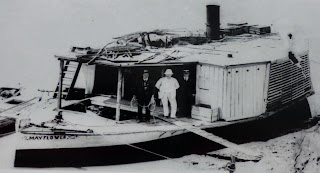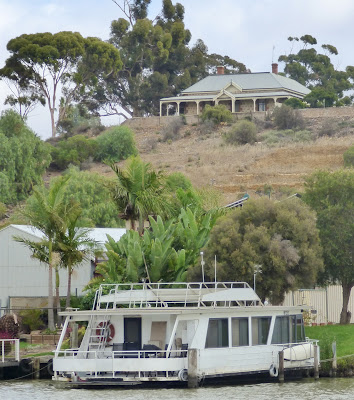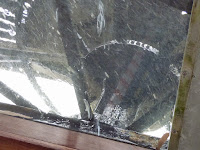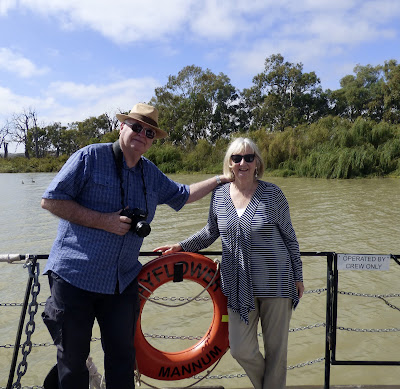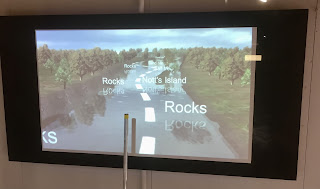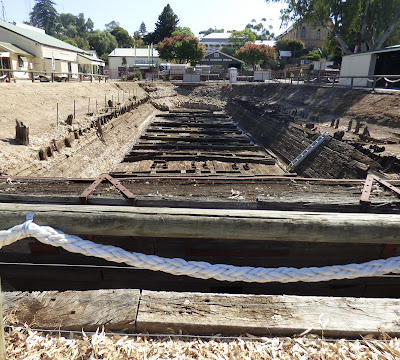Last week we decided to head for Mannum, a small town on the Murray River, about 90 minutes north-east from home. It was established back in the 1850s when William Randell built the first steamboat on the river and developed a thriving freight business. The town quickly developed as a vital link in the subsequent bustling river trade, servicing the pastoralists who had moved into the area.
The brochure we picked up at the Information Centre says 'Fortunately Mannum retains much of the main street as it was a century ago '. However, I must say I was a bit disappointed as, apart from the Post Office, Institute and the Pretoria hotel, I found any atmosphere of the past sadly missing. The brochure went on to tell me to 'Observe the historical plaques which are displayed on many of the buildings'. I saw none! Quite a few references in the brochure alluded to ' the site of the Shearer factory, now a carpark; Enjoy the view of the reserve which once boasted a wading pool, swimming pool and diving tower'. So we needed a bit of imagination to view the past. I may be a bit unfair here, because the brochure provided detailed explanations of three walks we could have done which would have taken us past gracious homesteads, former factories, and old cottages. We opted for the easy main street walk and so probably missed out on much of Mannum's hidden history. Here's the Institute.

I did like the colourful mural on a wall that evoked the town's riverboat heritage.
However, things looked up when we wandered along the foreshore and saw the majestic paddlesteamer Marion, moored at the river's edge. For me, this immediately conjured up visions of Huckleberry Finn and Tom Sawyer on the banks of the Mississippi. And then I thought of Ava Gardener and Howard Keel singing in the movie Showboat. But most of all, I remembered the television series from the 1980s based on Nancy Cato's 1958 novel All The Rivers Run with evocative shots of steamboats chugging along the Murray River with their cargo of wheat and wool, steam billowing from the smokestacks, whistles blowing and the paddles constantly churning through the water.
But we had booked a much smaller vessel that did 90 minute cruises up the Murray. I always head to any information board that will explain where I am or what I'm looking at, and on the interpretation sign in front of the vessel I read that our paddlewheeler was the Mayflower, a lovely restored boat that had been built in 1884 for Daniel Alexander, a West Indian, and is one of the oldest paddlewheelers in South Australia. Here were two photos of the vessel in the 1890s and in 1915.
The boat had recently been restored by volunteers, with an upper deck added.
Although it doesn't look as appealing or evocative of the past as the Marion, it felt welcoming, and was spacious and comfortable. Off we went with a handful of other tourists. Unfortunately the sun had decided to sulk so it was grey skies and a chill wind that accompanied us. Nevertheless, we had a wonderful view of the river which our skipper/guide told us we were seeing at its most widest part. I was amazed at the number of houseboats moored on the bank.
Here's a portion of what we saw. Close to Mannum, there were glimpses of houses, moored boats and the foreshore.
After a while there was no hint of civilisation, just the river, the foreshore, the treed bank, a tiny backwater, an occasional bird or waterfowl.

A kite soars overhead, while a magpie looks on.
And another kite coming in for a landing.
It was peaceful with just the river and the trees, although you can see by the photos how dull the sky was and, with no sun, no sparkle on the water.

I managed to get a shot of the paddles turning.
This next photo shows the kilometre marker showing how many kms we were from the mouth of the Murray at Goolwa.
I was curious about the flag that was flying at the prow of the boat. It turns out it is the flag of the Murray River. The four blue stripes are for the major rivers of the Murray system - the Murray, Darling, Murrumbidgee and Goulburn. The three white stripes are for the states the Murray passes through - New South Wales, Victoria and South Australia. The five stars on the cross of St George represent the five colonies at the time the flag was designed (1853). And the Union Jack of course, representing England!
Observant readers will have noticed the blue sky. Yes - the sun had finally appeared and with it a lovely warmth and a stilling of the breeze. By now we were cruising alongside the clay cliffs that are a feature of this part of the Murray.
All too soon we were turning around and heading back to Mannum. But not before we had a photo taken of the two of us, actually together in a photo for once (thanks to a kind tourist).
The cruise had been all we hoped for, and with excellent commentary from the skipper, I felt I knew so much more about this part of the Murray system. Back on shore we toured the museum which was well curated and told us more of the history of the town and the paddlesteamers.
Steve then had a go at navigating down the river using the fake wheel and navigation markers setup in a corner of the museum.
Our museum ticket also gave us access to the Marion paddlesteamer, so we hopped aboard.
I was amazed at the intricate workings of the vessel. No wonder it takes so many volunteers to keep it in tip-top condition. Of course, all I could do was marvel at the engineering and machinery and couldn't resist singing Creedence Clearwater's Proud Mary with its lyrics 'big wheel keep on turnin' ... Proud Mary keep on burnin' ... rollin' , rollin', rollin' on the river'.
And here's the wood it needs.
Outside, we saw the dry dock which played an important part in repairing and outfitting vessels on the Murray as, in the 1870s to the 1920s, it was the only dry dock on the inland river system.
Plans are underway to cover the dock to preserve the red gum timbers. One website told me that it is the only dock of its kind in South Australia, and another site said 'the only one of its type in the world.' Regardless, it is heritage protected and a valuable part of Mannum's history.
Crossing the Murray had always been a problem, especially for the early explorers and settlers. At many points along the river, ferries or punts eventually provided the solution, and later, bridges. Mannum relies on its free cable car ferry.
Here we go.
Goodbye Mannum. Another great day out exploring South Australia.



